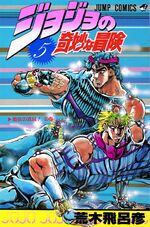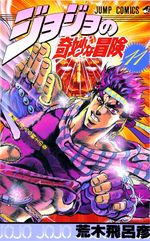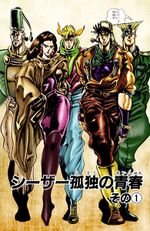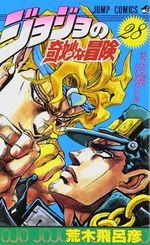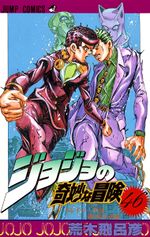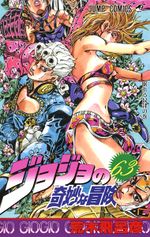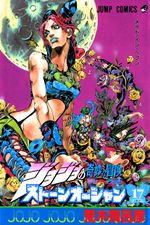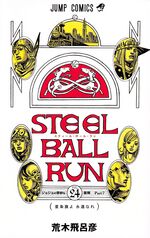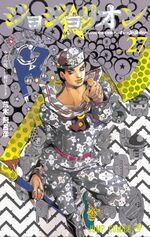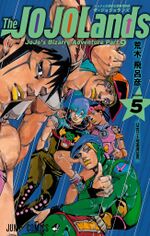JoJo's Bizarre Adventure
JoJo's Bizarre Adventure (ジョジョの奇妙な冒険, JoJo no Kimyō na Bōken), commonly shortened to JoJo, is an ongoing shonen and seinen manga written and illustrated by Hirohiko Araki since December 1986. The story spans nine parts, each following a different protagonist from the Joestar bloodline, with new settings and eras introduced in every installment.
JoJo's Bizarre Adventure was originally serialized in Weekly Shonen Jump from 1986[a] to 2004. Shortly after the seventh part began, serialization moved to the monthly seinen magazine Ultra Jump in 2005, where the series continues in its ninth part. JoJo's Bizarre Adventure is collected in a variety of formats ranging from standard tankōbon and paperback volumes to special editions such as hardcover "JoJonium" editions and omnibuses, all of which contain the manga as it was serialized in Weekly Shonen Jump and Ultra Jump, albeit with differences in chapter names and slight dialogue adjustments.
The series has over 120 million copies in print,[3] making it one of the best-selling manga series in history. Filling 136 volumes, it is also Shueisha's longest-running manga series as of December 2024.
Summary
JoJo's Bizarre Adventure spans multiple genres, including Action, Adventure, Supernatural, Thriller, Comedy, Tragedy, Mystery, Slice of Life, and Horror. The series is best known for its Stand phenomenon, the Stardust Crusaders arc featuring Jotaro Kujo and DIO, its expressive depictions of charismatic and eccentric personalities, its bizarre poses, iconic dialogue, unique onomatopoeia, and extensive references to Western popular culture.
Araki has expanded the JoJo universe through various one-shots and artbooks. Several spin-offs and light novels by other authors have also been published, many featuring original illustrations by Araki.
For years, JoJo held the distinction of being Shueisha's longest-running manga without a television anime adaptation. While Stardust Crusaders received an OVA adaptation and the Phantom Blood arc was adapted into a theatrical anime film, an official TV anime series by David Production finally debuted on October 6, 2012, 25 years after the manga's serialization began. A live-action film adaptation of Diamond is Unbreakable was also released in 2017.
The franchise has also expanded into various forms of merchandise, including collectible figures, mobile applications, and video games, with multiple fighting games released internationally. The most recent, All-Star Battle R, was published by Bandai Namco in 2022 for PlayStation 4, PlayStation 5, Nintendo Switch, Xbox One, Xbox Series X & S, and Steam.
The story in JoJo unfolds across two continuities. The first continuity encompasses Parts 1 to 6, serialized in Weekly Shonen Jump from 1986 to 2003, while the second continuity consists of Parts 7 to 9, serialized in Ultra Jump from 2005 to the present.[b] The narrative is structured into multi-chapter arcs that depict precarious, melodramatic conflicts between opposing parties, each defined by their unique supernatural abilities—most notably the versatile Stand phenomenon—as well as their distinct ambitions, ideologies, or moral codes. These arcs shift in tone, blending adventure, suspense, mystery, and horror through action, often interwoven with elements of comedy.
Numerous references to modern film, television, fashion, fine art, and popular music appear in JoJo in various settings, influencing both character design and nomenclature. Additionally, the series integrates concepts from physics, mathematics, psychology, biology, technology, mythology, natural phenomena, historical events, and other artistic works to shape the design and mechanics of its many unique Stands. At times, the story extrapolates on contemporary scientific theories, presenting imaginative interpretations of how certain Stands and other powers interact with nature.
Morioh, the fictional Japanese town that serves as the primary setting of Diamond is Unbreakable and its distinct counterpart in JoJolion, is geographically aligned with Araki's hometown, Sendai.[4] This setting incorporates richer cultural details and more contemporary themes, such as the 2011 Tohoku earthquake, compared to other locations in the series. Additionally, Stand-wielding manga artist Rohan Kishibe, a Morioh resident introduced in Diamond is Unbreakable, returns as the protagonist and narrator of the spin-off series Thus Spoke Rohan Kishibe.
When asked in 2006 about the central theme of JoJo, Hirohiko Araki described it as "the enigma of human beings" and "an ode to humanity," while characterizing his approach to manga as "the salvation of the heart."[5] Thematically, the series explores ideas of courage, justice, and fate.
Plot Summary

The first continuity of the series follows an intergenerational conflict between the Joestar family and various malevolent forces, the most prominent being Dio Brando and his followers.
Parts 7-9 take place in an alternate continuity from the events of Parts 1-6. In this second continuity, characters, locations, and concepts resembling those in the original universe appear, but the Stand abilities and events surrounding them are drastically different. This continuity follows the story of Johnny Joestar and his descendants, as well as the mystery of the Saint's Corpse.
Although Araki has referred to the continuity of Parts 7-9 as a continuation of the universe seen at the end of Part 6,[6][7] he has also stated that the settings of Diamond is Unbreakable and JoJolion are not connected in space or time.[8] Furthermore, the relationship between the two continuities remains ambiguous, as described in JOJOVELLER.[9]

The first part, Phantom Blood, takes place in England between 1880 and 1889, following Jonathan Joestar as he grows up alongside and ultimately battles his adoptive brother, the cunning and ruthless Dio Brando. After acquiring an ancient Stone Mask, Dio transforms into a vampire, forcing Jonathan to master the martial art of the Ripple under the guidance of Will Anthonio Zeppeli. The Ripple, a life-energy technique transmitted through hand-to-hand combat, is one of the only means aside from sunlight to destroy vampires and their zombie minions.
The second part, Battle Tendency, follows Jonathan's grandson, Joseph Joestar, set in New York between 1938-1939. Joseph travels to Mexico, Italy, and Switzerland to combat the Pillar Men, an ancient race of formidable beings responsible for the creation of the Stone Mask. Like his grandfather, Joseph undergoes rigorous Ripple training alongside Caesar Anthonio Zeppeli, Will's grandson, under the tutelage of the enigmatic Lisa Lisa. Together, they fight to prevent the Pillar Men from acquiring the Red Stone of Aja, a gem that would allow them to perfect the Stone Mask, rendering them immune to sunlight and granting them supreme control over life itself.

The third part, Stardust Crusaders, is set between 1988 and 1989.[c] Joseph's grandson, Jotaro Kujo, embarks on a journey from Tokyo, Japan to Cairo, Egypt alongside Joseph, Muhammad Avdol, and Noriaki Kakyoin. Their goal is to rescue Jotaro's mother, Holy Kujo, from her life-threatening illness caused by the Joestar family's supernatural connection to DIO, who has returned from the depths of the ocean after a century. Along the way, they recruit the French swordsman Jean Pierre Polnareff and the dog Iggy, fighting various agents sent by DIO throughout Hong Kong, Singapore, India, Pakistan, and Egypt.
From this point onward, protagonists and antagonists alike primarily wield Stands, which are manifestations of their fighting spirit, marking one of the series' most defining features. Araki originally envisioned JoJo's Bizarre Adventure as a trilogy, but the series continued beyond the conclusion of Stardust Crusaders.[10][6]
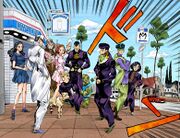
The fourth part, Diamond is Unbreakable, takes place in 1999 in the fictional town of Morioh, Japan. The story follows Joseph’s illegitimate son, Josuke Higashikata, as he navigates a growing population of Stand users, many of whom were created by the Bow and Arrow, the same artifact that awakened DIO's Stand. Alongside Okuyasu Nijimura, Koichi Hirose, Jotaro Kujo, and Rohan Kishibe, Josuke embarks on a hunt for the elusive serial killer Yoshikage Kira, who has been murdering Morioh's residents for years.
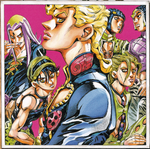
The fifth part, Vento Aureo, is set in Italy in 2001 and follows DIO's son, Giorno Giovanna, as he infiltrates Passione, Italy's most powerful gang. With aspirations of reforming the organization to rid it of its corrupt drug trade, Giorno allies with Bruno Bucciarati and his team, consisting of Leone Abbacchio, Guido Mista, Narancia Ghirga, and Pannacotta Fugo. Initially tasked with protecting the daughter of the gang's Boss, Trish Una, from the traitorous La Squadra Esecuzioni, they eventually betray the gang as well upon discovering that the Boss intends to kill Trish to protect his identity.
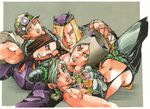
The sixth part, Stone Ocean, takes place in 2011, centering on Jotaro's estranged daughter, Jolyne Cujoh, who is framed for murder and incarcerated in Green Dolphin Street Prison. When Jotaro attempts to rescue her, he falls victim to Whitesnake, a Stand that steals both his Stand and memories. Determined to uncover the identity of Whitesnake's user, save her father's life, and thwart the greater conspiracy at play, Jolyne allies with fellow inmates Ermes Costello, Foo Fighters, Narciso Anasui, and Weather Report, under the guidance of the young but resourceful Emporio Alnino. As they delve deeper into the prison's mysteries, they uncover Enrico Pucci's grand scheme to achieve "Heaven", a plan influenced by the late DIO.
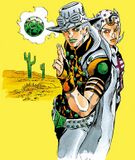
The seventh part, Steel Ball Run, is set in 1890, following a transcontinental horse race across the United States known as the Steel Ball Run, organized by Steven Steel. Gyro Zeppeli, a master of the mysterious Spin technique, enters the race to win the cash prize of $50,000,000, hoping to convince the king of Naples to grant amnesty to a boy sentenced to death. Johnny Joestar, a paraplegic former jockey, hopes to regain the use of his legs through mastering the Spin. The two soon discover that the race serves as a cover for President Funny Valentine's secret mission to gather the holy Corpse Parts of Jesus Christ, leading them into a conflict against Valentine and his government agents in pursuit of these sacred relics.
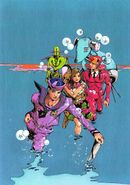
The eighth part, JoJolion, jumps forward to 2011, following university student Yasuho Hirose as she discovers an amnesiac man, later named "Josuke," buried in the rubble of Morioh after the Great East Japan Earthquake. As Yasuho and Josuke investigate his past, they initially suspect he may be the ship doctor Yoshikage Kira. Josuke is taken in by the affluent Higashikata Family, but his search for the truth soon leads him to uncover the family's hidden past, their connection to the enigmatic Rock Humans, and a mysterious "Locacaca" fruit with the power to break their generational curse. As their investigation deepens, Josuke and Yasuho join forces with the skilled horticulturist Rai Mamezuku, who possesses crucial knowledge about the Locacaca. However, their pursuit of the fruit entangles them in a deadly struggle against the Rock Humans, culminating in a battle against calamity itself.
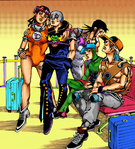
The ninth part, The JOJOLands, is set in the volcanic islands of Hawaii in the 2020s. It follows Jodio Joestar, a high school student with antisocial personality disorder, who dreams of becoming rich. Jodio works as a gofer for a small gang run by his principal, Meryl Mei Qi, alongside his older brother Dragona Joestar and schoolmates Paco Laburantes and Usagi Alohaoe. After joining forces with Hawaii Island native Charming Man, the group embarks on a heist to steal a plot of private land owned by an infrastructure development company named HOWLER. The land is linked to the disappearance of Charming Man's brother, and the team relies on the power of a mysterious Lava Rock pilfered from Rohan Kishibe to achieve their goals.
Publication
Chapters are serialized in Weekly Shonen Jump and Ultra Jump, under Shueisha. While in Weekly Shonen Jump, the series was published under the tagline "Romance Horror! -A Crimson Tale-" (ロマンホラー!—深紅の秘伝説—, Roman Horā! -Shinku no Hi Densetsu-). The tagline was created by the editorial department at Shueisha and was included in every chapter up until Stone Ocean.
International Publication
In North America and the United Kingdom, Stardust Crusaders was translated into English and published in 16 volumes by VIZ Media from November 8, 2005 to December 7, 2010 under the title of JoJo's Bizarre Adventure, skipping both Phantom Blood and Battle Tendency. On June 9, 2014, VIZ Media published the first three parts of JoJo's Bizarre Adventure from the JoJonium line of manga, from February 24, 2015 to February 5, 2019, marking the first English publications of Phantom Blood and Battle Tendency. On July 6, 2018, VIZ Media announced they would be releasing an English publication of Diamond is Unbreakable. The first volume of Diamond is Unbreakable was released on May 7, 2019, and finished on May 4, 2021. On August 3, 2021, VIZ Media released the first volume of Vento Aureo in English. On February 3, 2023, VIZ Media announced they would be releasing an English publication of Stone Ocean in fall of that year.
In Italy, Star Comics began publishing the series in a monthly format under the title Le bizzarre avventure di JoJo from November 1993 to April 2004.[11] These monthly releases contained around five chapters in each trade paperback, with 126 paperback volumes released for the first six parts. Starting with Steel Ball Run, published from March 2006 to February 2012, new volumes are published in the Japanese (tankōbon) format. In 2010 Star Comics began publishing the Bunko Edition, completely replacing the original releases of the first 7 parts. Having completely released JoJolion (February 2014-July 2022) and the JoJonium release of Parts 1-3 (October 2019-May 2022), they are up to date with the series as of December 2022.
In France, the first four parts were published by J'ai lu[12] from January 2002 to December 2005. In 2007, publisher Tonkam (now a subsidiary of Delcourt) resumed the publication of the following parts starting with a publication of Vento Aureo. The previous parts would later see revised releases under Tonkam's publication, starting with Stardust Crusaders before going back to Phantom Blood and continuing from there. Currently, they are publishing JoJolion.[13]
In Taiwan, JoJo was illegally distributed under the title Strongman Front (強人陣線) by Tong Li Comics for many years until Daran Comics obtained the official publishing license for JoJo, renaming the comic to JoJo Adventure Wild (JoJo冒險野郎). On March 31, 2003 Daran Comics shut down their offices and the license for JoJo was officially obtained by Tong Li Comics, who now officially distributes the series under the original title of JoJo's Bizarre Adventure (JoJo的奇妙冒險). In Hong Kong, the publisher of the series is World Publishing Limited under the label Comics World, who have published all of JoJolion.[14][15] In China, the series is distributed digitally by Bilibili Comics, who have published the entire series; they are currently publishing The JOJOLands in simultaneous release with the Japanese edition.[16]
Creation and Development
When he first conceived JoJo's Bizarre Adventure, Araki was throwing around several core ideas he wanted to portray such as an idea of succession between generations, but also to show traveling heroes. From there he began to set up his ideas for Phantom Blood. Araki notes that the process of creating JoJo went from fighting to a more spiritual aspect, and that concepts like friendships took a greater place over time.[17] Araki had several themes in mind too, such as the idea of "mystery",[18] and notably the mystery coming from bloodlines. He also asked himself "Who is the strongest person in the world?" and derived from this question themes such as immortality, seeking life, or justice.[18] More importantly, Araki felt that he could create something unique among the current series at Weekly Shonen Jump with these ideas. Araki had initially only planned for three parts,[19] but decided to continue with his series.
Writing JoJo
Araki gives precedence to emotion and inner thought over plot structure, trying to portray the protagonists' destiny.[18] He follows a particular narrative style that he calls the "golden way" down the "royal road" of creating manga, characterized by strong and determined protagonists who constantly advance towards their objectives. This "royal road" is, according to him, the best way to draw in the audience. One example of his "royal road" is the plot of Stardust Crusaders during which the heroes always manage to defeat the enemies on their paths and inexorably approach Egypt. Araki is not averse to killing off his protagonists like Jonathan Joestar, feeling that if the death served a greater purpose then he still abides by the "royal road".[20] Araki thinks the basic plot of his parts center around a particular predicament and likes to throw his protagonist quickly into said predicament before continuing off his story from there (e.g. Johnny Joestar is paraplegic and wants to find a way to heal his legs).[20] Araki also use a rather original plot structure for the series. Instead of the classical "tournament" format of most other series at the time where the heroes fought enemies in a predictable increasing order of strength, Araki adopted a sugoroku style (sugoroku is a table-top game similar to snakes and ladders) where the heroes would travel and then meet enemies at particular points in said journey. The fights would be more varied due to a better variety of powers, and there would be an emphasis on wit rather than force.[21] Araki also denounces the long-term limitations of always increasing the strength of enemies in a serialized manga.[18][22]
Araki takes inspiration from a variety of sources to write his series. He has confirmed several times that he uses Western music to name his characters, but is also influenced by designs from varied sources such as artbooks, comic books, the news, or movies. Araki extensively uses books rather than online research.[23] One lesser known aspect of his research is that he often travels to the places he depicts in the series in order to have a better feeling of the place and gather details that an online research wouldn't give. His first editor, Ryosuke Kabashima, encouraged him to see movies for inspiration and also travel.[24] Kabashima notably coerced Araki into traveling to Egypt to later depict it in Stardust Crusaders.[25] Araki would later on keep this habit, traveling to Italy for Vento Aureo,[26] to a correctional facility in Florida to get inspiration for Green Dolphin Street Prison,[27][28], as well as to Orlando.[29] He also went on several long journeys in the USA and Japan to improve his writing for Steel Ball Run.[30] His habit of traveling to research places extended to individual buildings such as a hospital or a drug store.[31] Prior to writing The JOJOLands, he flew to Hawaii, particularly to Oahu Island and Hawaii Island, taking photos of specific locations like the school Jodio Joestar attends and the villa where Rohan Kishibe stays.[32]
Araki makes it a point to never rest on his laurels and always find new ideas. For instance, Araki was displeased to think he had reached a summit with Stone Ocean in terms of ideas, deciding to erase the original continuity and revisit his old ideas in a second continuity.[33] His will to always change is also noticeable in his art (though he explains it as avoiding drawing old art rather than deliberately change).[34] Araki's art style has changed considerably over the years, although he had always kept core ideas about his art such as his dramatic poses and representation of an ideal human body. For instance, muscle-bound heroes were popular in the 80s so Araki drew these types of characters (e.g. Jonathan), but as trends changed, Araki transitioned to more normal-looking characters like Giorno, a slimmer pretty boy character type.[17][35] The unusual sound effects Araki inserts in his pages are inspired from horror movies and rock music, akin to scare chords and other noises produced by synthesizers and mellotrons.[35] More specifically, the music which plays in a scene where a woman gets stabbed in Alfred Hitchcock's Psycho inspired Araki to try and express the same sense of "impending danger" using sound effects in his manga.[36]
During its publication in the Weekly Shonen Jump magazine, Araki continuously tried to push for unique ideas, often infringing on what was considered acceptable for the magazine. Araki notably decided to make his first protagonist a foreigner and then kill him off to replace him, which was a taboo. Araki also had tried to write female protagonists for the series, with notably Giorno Giovanna being initially thought of as a young woman. This would be eventually portrayed with Jolyne Cujoh, whose sex he insisted on despite his editor's requests. Araki notably thought that it was then acceptable to portray women being subjected to violence as intense as male characters were being exposed to.[35][37] However, the risks Araki took led to several conflicts with the editorial team who tried to tone down the violence and themes Araki wanted to write about.[38]
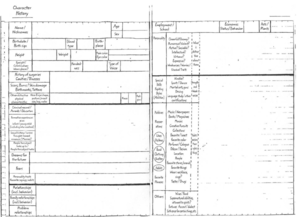
When Araki creates a character, he thoroughly completes a datasheet about said character, which includes their physical characteristics, their tastes, and background information like a potential family.[39] Araki notes that his habit of naming characters after bands and albums is a simple hobby, and a way to pay his respect to the musicians he likes.[18]
During his time at Weekly Shonen Jump, Araki had the following schedule: Sundays were spent finding ideas; Mondays were spent making the draft storyboard for the chapter, meeting with his editor, and drawing more elaborate sketches, one page at a time; Tuesdays, Wednesdays and Thursdays were spent finishing drawing the chapter for the publication in the magazine; and Fridays and Saturdays were spent resting.[40] This schedule that Araki followed strictly was also set up by his first editor, Kabashima.[24] This notably allowed Araki to keep in shape, and he was also noted as being always on time for his chapters.[41] His currently monthly schedule seems to have stayed the same as his weekly schedule, with Fridays and Saturdays off. Araki adds that he wakes up at 10 AM, begins working at 11 AM, takes a break at noon, and finishes his work day at Midnight.[42] He believes that his current schedule of creating 45 pages a month matches his natural pace better.[23] Thanks to his strict schedule, Araki has never missed a deadline in his career.[23][41]
See also
Notes
- ↑ The official anniversary of the series is celebrated on January 1, 1987.
- ↑ Part 7, Steel Ball Run, was also initially serialized in Weekly Shonen Jump until its 23rd chapter released on October 18, 2004.
- ↑ The timeframe of Stardust Crusaders was originally stated as 1987-1988 before later being revised to 1988-1989 in both the manga and anime.
References
- ↑ Baoh: The Visitor Issue #1 English Author's Note
- ↑ https://www.viz.com/jojo-s-bizarre-adventure Official Website for JoJo's Bizarre Adventure
- ↑ Vish (December 18, 2021), "My Rohan Kishibe Talk - JoJo's Bizarre Adventure Has Printed 120,000,000 Copies", JoJo's Bizarre Encyclopedia.
- ↑ Morioh Map (JoJolion)
- ↑ Tokai Lecture (June 2006)
- ↑ Jump up to: 6.0 6.1 Interview:JoJo Could Have Ended with Part 4 (October 2012)
- ↑ Interview:Aomaru Jump (February 2004)
- ↑ Interview:All-Star Battle Strategy Guide (August 2013)
- ↑ Interview:JOJO JOURNEY (September 2013)
- ↑ JoJonium Volume 8 (Jotaro Kujo) - Special Interview
- ↑ Le bizzarre avventure di JoJo First Italian release November 1993
- ↑ J'ai lu
- ↑ Hirohiko Araki - Delcourt
- ↑ Comic World's Facebook post on JoJolion 27
- ↑ JoJo的奇妙冒险 Chinese Wikipedia page for the JoJo series
- ↑ 乔乔的奇妙冒险 第9部 The JOJO Lands - 哔哩哔哩漫画
- ↑ Jump up to: 17.0 17.1 Animeland Interview 06/2003
- ↑ Jump up to: 18.0 18.1 18.2 18.3 18.4 Tokai Lecture 06/2006
- ↑ Weekly Shonen Bracket 100Q
- ↑ Jump up to: 20.0 20.1 Hirohiko Araki's Manga Techniques Chapter 4
- ↑ NYT Japan interview 11/2018
- ↑ Volume 45, Volume 46 - Author's Note
- ↑ Jump up to: 23.0 23.1 23.2 Dream Talk Sessions 2013
- ↑ Jump up to: 24.0 24.1 JOJOVELLER History 1979-2013
- ↑ Manga Heaven 06/2007
- ↑ Volume 48 Author's Note
- ↑ SO Volume 1 Special Thanks
- ↑ SO Volume 5 Author's Note
- ↑ SO Volume 12 Author's Note
- ↑ P7 Bunko 1 afterword
- ↑ Volume 41 Author's Note
- ↑ Hirohiko Araki's Research Techniques (December 2023)
- ↑ P6 Bunko Vol.11 Afterwords
- ↑ JOJOmenon interview
- ↑ Jump up to: 35.0 35.1 35.2 Phantom Blood PS2 Game interview
- ↑ Mainichi Shimbun interview
- ↑ P6 Bunko Vol.1 Afterwords
- ↑ P5 Bunko Vol.1
- ↑ Manga in Theory and Practice Chapter 3
- ↑ JoJo 6251 Araki interviews
- ↑ Jump up to: 41.0 41.1 JOJOVELLER 2013 Azuma interview
- ↑ Asahi Shimbun interview

